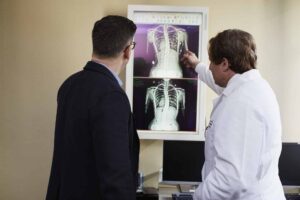Are you looking for “The Woodlands TX ankylosing spondylitis doctor?” You should contact Advanced Rheumatology of Houston to schedule an appointment. Our sole rheumatologist, Dr. Tamar F. Brionez, has more than ten years of experience in the field of rheumatology. Rheumatologists diagnose and treat arthritis, lupus, gout, ankylosing spondylitis, and a plethora of other rheumatologic conditions.
Rheumatologic conditions or diseases affect the connective tissues within the body. Connective tissues include joints, ligaments, muscles, organs, and bones. Dr. Brionez has more than ten years of diagnosing and treating these conditions.

Dr. Tamar Brionez
Dr. Brionez started her medical career by studying Nutritional Science at Texas A&M University. After she completed her Bachelor of Science there, she attended Baylor College of Medicine for her Doctor of Medicine. She also completed her Fellowship in Rheumatology at the University of Texas Health Science Center.
In 2007, Dr. Brionez became board-certified in internal medicine. Two years later, in 2009, she became board-certified in rheumatology. Since then, Dr. Brionez has been practicing rheumatology. She has helped diagnose and treat a wide variety of patients with ankylosing spondylitis. Of course, she can help patients with a wide variety of conditions. You can see the full list of conditions below.
- Gout
- Myositis
- Osteoarthritis
- Osteoporosis
- Polymyalgia Rheumatica
- Psoriatic Arthritis
- Rheumatoid Arthritis
- Scleroderma
- Sjögren’s syndrome
- Spondyloarthropathies (ankylosing spondylitis)
- Systemic Lupus Erythematosus (Lupus)
- Vasculitis
Spondyloarthropathies
The term spondyloarthropathies refers to a group of inflammatory rheumatologic conditions, which are a form of arthritis in areas where bone and tendon attach. These areas are known as entheses. Typically, these types of diseases appear in the spine. Symptoms usually appear in two stages. The first is pain and stiffness in the lower back. The second is bone destruction, which can lead to deformity.
Ankylosing spondylitis is just one type of disease within this family. In fact, it is the most common type of spondyloarthropathy. Other diseases in this family include axial spondyloarthritis, reactive arthritis, and psoriatic arthritis.
Ankylosing Spondylitis
Ankylosing Spondylitis is the most common type of spondyloarthropathy. This disease will cause small bones in the spine to fuse together. The fusion of vertebrae will cause the patient to hunch forward or develop another type of deformity. In some cases, the ribs are affected, and breathing becomes difficult.
As aforementioned, symptoms will first appear as pain and stiffness in the lower back, shoulders, or hips. Times after long periods of inactivity like the mornings are when the symptoms are the worse. When the shoulders, arms, and legs feature pain, it is considered peripheral spondyloarthritis.
Ankylosing Spondylitis is a hereditary condition with 30 genes identified. The gene most associated with the disease is HLA-B27. However, there is still a lot to learn about the cause of this disease. The demographic most affected by this condition are young men in their teens and early twenties.

Ankylosing Spondylitis can be diagnosed through advanced imaging tests.
Men develop ankylosing spondylitis about two or three times more than their female counterparts. If a patient’s family member has the condition, then they are at a higher risk of developing the disease. However, it varies on the inheritance of the HLA-B27 gene.
Diagnosing and Treating Ankylosing Spondylitis
In order to diagnose ankylosing spondylitis, Dr. Brionez would have to view the patient’s medical history and perform a physical exam. Imaging tests are also an important aspect of the diagnosis. Advanced imaging tests like x-rays and MRIs will help determine a change within the vertebrae. In some cases, a blood test for the HLA-B27 gene may be required. If the patient is diagnosed, then treatment is geared toward controlling symptoms and stopping potential deformities.
There is no cure for ankylosing spondylitis. So, the first line of defense against the disease is nonsteroidal anti-inflammatory drugs or NSAIDs. As long as the correct dose is given, these medications can be beneficial in relieving pain and stiffness. In the case of swelling, corticosteroids are very effective. Above all, physical therapy and joint exercises are beneficial.
Living with Ankylosing Spondylitis
The symptoms of ankylosing spondylitis can appear and disappear throughout patients’ lives. However, patients with ankylosing spondylitis live normal lives with the same average lifespan as other people. Of course, there are always steps patients can take to improve their health with this disease.
Firstly, patients should stop smoking. Smoking increases the speed of spinal fusion. Secondly, patients should exercise regularly. A regular exercise regimen will lead to fewer symptoms and healthier life. Finally, patients should find a support group to help navigate this disease. The Spondylitis Association of America and the Arthritis Foundation are great ways of finding a group.
Impacting Greater Health
Patients with ankylosing spondylitis or other spondyloarthropathies have the potential of developing other conditions or complications. For example, inflammation of the eye appears in about 40 percent of patients with spondyloarthritis. Redness and pain in the eye is a common symptom.

It is beneficial to find a support group for your condition.
Another condition you could develop is osteoporosis, which appears in about in approximately 50 percent of spondyloarthritis patients. Osteoporosis is the loss of bone mass and appears in women more than men. Patients with fused vertebrae are more likely to develop this condition.
In addition to osteoporosis, psoriasis can appear. This condition develops patches of red or white scaly skin near the elbows or knees. A dermatologist can help treat this skin condition. Patients may also experience intestinal inflammation or aortic valve inflammation. In the case of intestinal inflammation, patients may need to see a gastroenterologist. A rheumatologist can determine if the aortic valve in the heart is being affected by inflammation.
The Woodlands TX Ankylosing Spondylitis Doctor
Advanced Rheumatology of Houston has the resources of diagnosing and treating Ankylosing Spondylitis and a slew of other rheumatologic conditions. Dr. Brionez has more than ten years of experience, diagnosing and treating these conditions. If you are experiencing the symptoms of ankylosing spondylitis, then contact Advanced Rheumatology of Houston today.
You can reach our clinic by calling (281) 766-7886. You may also reach us by filling out the form on our contact us page. Regardless, you can schedule an appointment at our Woodlands location. So, stop searching “The Woodlands TX Ankylosing Spondylitis Doctor” and start calling us!
Fun Facts about The Woodlands
- Catch a movie every second Saturday at Free Family Movie Night in Creekside Park!
- Woodlands area has five major hospitals!
- One of the largest parks in Woodlands is the Rob Fleming Park & Aquatic Center.
- Read more facts about The Woodlands here.


